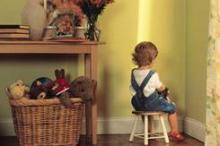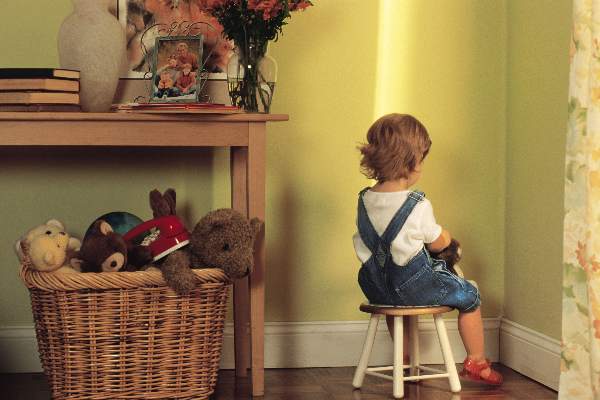User login
The last portion of the Centers for Disease Control and Prevention’s online resource, “Essentials for Parenting Toddlers and Preschoolers,” focuses on using time-out as a form of discipline, and offers guidance on how and when this method should be used with young children.
When used correctly, time-out can be very effective in stopping undesired behavior, because children dislike being bored, and time-out removes the child from all sources of fun, activity, and attention.
So when should a parent use time-out?
The CDC recommends using time-out in the following situations:
1. The child has done something dangerous, such as running in the street.
2. The child has done something harmful to another child, such as fighting or biting.
3. The child has broken a family rule.
4. The child continues the misbehavior after a warning.
A warning can be used the first time the child misbehaves, and the time-out may be carried out if the child continues the unwanted behavior. CDC offers the following steps parents can take when using time-out:
1. Give a warning. Let the child know what he has done wrong, and that if he does not stop, he or she will be put in a time-out.
2. Explain why. Calmly tell the child why they are in time-out. Do not argue, scold, or talk to your child when they are sitting in time out.
3. Administer the time-out. If the child repeatedly moves or leaves the time-out space, you may need to be persistent in putting him or her back in the time-out space. Limit your interaction as much as possible when doing this.
4. End time-out. A good rule of thumb is to have the child sit in time-out for 1 minute per year of his or her age. For instance, a 4-year-old would sit in time-out for 4 minutes. Make sure your child has been quiet for at least 5 seconds at the end of time-out, and remind them what behavior you expect.
5. Praise the next good behavior the child does. This gives him or her a chance to follow directions properly.
For more information on using time out, visit the CDC website. To view examples of how to use this form of discipline, watch the video “How to Use Time-Out.”
The last portion of the Centers for Disease Control and Prevention’s online resource, “Essentials for Parenting Toddlers and Preschoolers,” focuses on using time-out as a form of discipline, and offers guidance on how and when this method should be used with young children.
When used correctly, time-out can be very effective in stopping undesired behavior, because children dislike being bored, and time-out removes the child from all sources of fun, activity, and attention.
So when should a parent use time-out?
The CDC recommends using time-out in the following situations:
1. The child has done something dangerous, such as running in the street.
2. The child has done something harmful to another child, such as fighting or biting.
3. The child has broken a family rule.
4. The child continues the misbehavior after a warning.
A warning can be used the first time the child misbehaves, and the time-out may be carried out if the child continues the unwanted behavior. CDC offers the following steps parents can take when using time-out:
1. Give a warning. Let the child know what he has done wrong, and that if he does not stop, he or she will be put in a time-out.
2. Explain why. Calmly tell the child why they are in time-out. Do not argue, scold, or talk to your child when they are sitting in time out.
3. Administer the time-out. If the child repeatedly moves or leaves the time-out space, you may need to be persistent in putting him or her back in the time-out space. Limit your interaction as much as possible when doing this.
4. End time-out. A good rule of thumb is to have the child sit in time-out for 1 minute per year of his or her age. For instance, a 4-year-old would sit in time-out for 4 minutes. Make sure your child has been quiet for at least 5 seconds at the end of time-out, and remind them what behavior you expect.
5. Praise the next good behavior the child does. This gives him or her a chance to follow directions properly.
For more information on using time out, visit the CDC website. To view examples of how to use this form of discipline, watch the video “How to Use Time-Out.”
The last portion of the Centers for Disease Control and Prevention’s online resource, “Essentials for Parenting Toddlers and Preschoolers,” focuses on using time-out as a form of discipline, and offers guidance on how and when this method should be used with young children.
When used correctly, time-out can be very effective in stopping undesired behavior, because children dislike being bored, and time-out removes the child from all sources of fun, activity, and attention.
So when should a parent use time-out?
The CDC recommends using time-out in the following situations:
1. The child has done something dangerous, such as running in the street.
2. The child has done something harmful to another child, such as fighting or biting.
3. The child has broken a family rule.
4. The child continues the misbehavior after a warning.
A warning can be used the first time the child misbehaves, and the time-out may be carried out if the child continues the unwanted behavior. CDC offers the following steps parents can take when using time-out:
1. Give a warning. Let the child know what he has done wrong, and that if he does not stop, he or she will be put in a time-out.
2. Explain why. Calmly tell the child why they are in time-out. Do not argue, scold, or talk to your child when they are sitting in time out.
3. Administer the time-out. If the child repeatedly moves or leaves the time-out space, you may need to be persistent in putting him or her back in the time-out space. Limit your interaction as much as possible when doing this.
4. End time-out. A good rule of thumb is to have the child sit in time-out for 1 minute per year of his or her age. For instance, a 4-year-old would sit in time-out for 4 minutes. Make sure your child has been quiet for at least 5 seconds at the end of time-out, and remind them what behavior you expect.
5. Praise the next good behavior the child does. This gives him or her a chance to follow directions properly.
For more information on using time out, visit the CDC website. To view examples of how to use this form of discipline, watch the video “How to Use Time-Out.”

